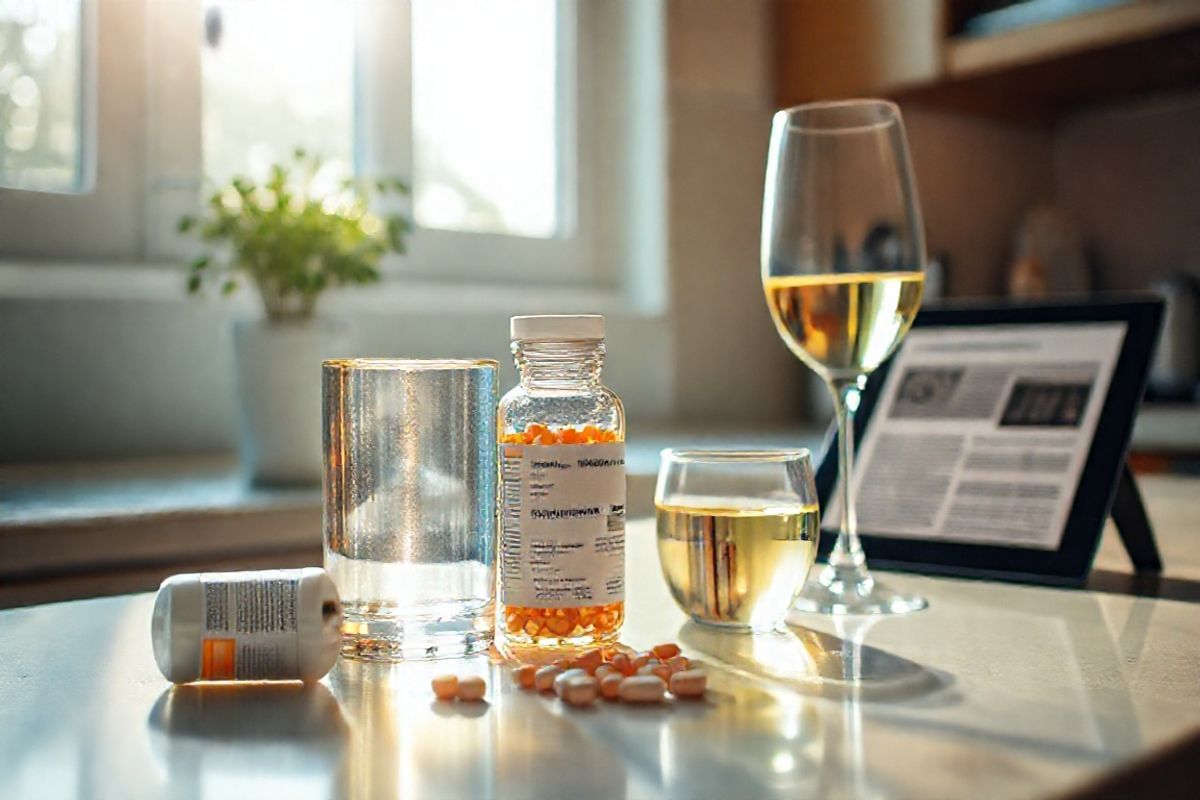Table of Contents
Understanding Amoxicillin: What You Need to Know Before Mixing

Amoxicillin is a widely used antibiotic belonging to the penicillin group, known for its effectiveness against a range of bacterial infections. It is commonly prescribed for respiratory tract infections, ear infections, urinary tract infections, and skin infections. The mechanism of action of amoxicillin involves inhibiting bacterial cell wall synthesis, which ultimately leads to the death of the bacteria (NIAAA, 2024).
When considering the use of amoxicillin, it is crucial to understand its pharmacokinetics and how other substances, particularly alcohol, may influence its effectiveness. Amoxicillin is absorbed well in the gastrointestinal tract, with peak plasma concentrations occurring approximately 1-2 hours post-administration. It is also metabolized by the liver and excreted through the kidneys, making the presence of other substances, such as alcohol, potentially impactful on its clearance and effectiveness.
The Risks of Mixing Amoxicillin with Alcohol: What the Research Says
The combination of amoxicillin and alcohol raises significant concerns regarding the potential risks and complications associated with their concurrent use. While there is no direct contraindication against alcohol consumption while on amoxicillin, several studies suggest that alcohol can interfere with the drug’s effectiveness and exacerbate side effects.
Research indicates that alcohol may hinder the immune system, which is already compromised during an infection (NIAAA, 2024). The use of alcohol can lead to dehydration, a condition that may further diminish the body’s ability to fight off infections. Additionally, excessive alcohol consumption can lead to liver damage, which may impair the metabolism of amoxicillin, resulting in decreased therapeutic efficacy and increased toxicity.
Furthermore, a review of various studies has shown that alcohol can amplify the side effects of antibiotics, including gastrointestinal disturbances, dizziness, and headaches (NIAAA, 2024). This interaction is particularly concerning for individuals who may be more sensitive to these effects, such as those with existing health conditions or those taking multiple medications.
How Alcohol Affects the Effectiveness of Amoxicillin

Alcohol consumption can negatively impact the effectiveness of amoxicillin in several ways. First, alcohol can lead to gastrointestinal issues such as nausea, vomiting, and diarrhea, which may hinder the absorption of the antibiotic (NIAAA, 2024). When the body is unable to absorb the medication adequately, the therapeutic concentrations of amoxicillin in the bloodstream may not reach the levels necessary to combat the infection effectively.
Moreover, alcohol can alter the gut microbiome, which plays a crucial role in drug metabolism and absorption. The disruption of the gut flora may influence the metabolism of amoxicillin, potentially leading to reduced effectiveness and increased risk of adverse effects (NIAAA, 2024).
It is important to note that chronic alcohol consumption can also lead to liver dysfunction, further complicating the metabolism of many medications, including amoxicillin. The liver is essential for processing and detoxifying substances in the body, and impairment can result in dangerous buildups of medications and their metabolites.
Symptoms and Side Effects: What to Watch For When Combining the Two
When combining amoxicillin with alcohol, patients should be aware of several potential side effects and symptoms that may arise from this interaction. Common side effects of amoxicillin include:
- Nausea and Vomiting: Both alcohol and amoxicillin can cause gastrointestinal upset. The combination may exacerbate these symptoms.
- Dizziness and Drowsiness: Alcohol can increase the sedative effects of amoxicillin, leading to enhanced dizziness and drowsiness.
- Headaches: Alcohol is known to trigger headaches in some individuals, and combining it with amoxicillin may increase the likelihood of experiencing this side effect.
- Allergic Reactions: Although not directly linked to alcohol, it is essential to monitor for signs of an allergic reaction to amoxicillin, such as rash, swelling, and difficulty breathing.
It is advisable for individuals taking amoxicillin to avoid consuming alcohol until they have completed their course of antibiotics and are no longer experiencing any symptoms of infection. This precaution helps minimize the risk of adverse effects and ensures that the antibiotic can work effectively.
Making Informed Choices: Guidelines for Safe Alcohol Consumption While on Amoxicillin
While it may be tempting to consume alcohol while taking amoxicillin, it is essential to prioritize your health and make informed decisions. Here are some guidelines for safe alcohol consumption while on amoxicillin:
-
Consult Your Healthcare Provider: Before mixing alcohol with any medication, including amoxicillin, it is crucial to consult your healthcare provider. They can provide personalized advice based on your health history and current medications.
-
Limit Alcohol Intake: If you choose to drink alcohol, limit your intake to moderate levels. For most adults, moderate drinking is defined as up to one drink per day for women and up to two drinks per day for men (NIAAA, 2024).
-
Stay Hydrated: Alcohol can dehydrate the body, which can hinder recovery from infections. Ensure you are drinking plenty of water to stay hydrated.
-
Monitor for Side Effects: If you do consume alcohol while on amoxicillin, be vigilant for any unusual side effects, including gastrointestinal distress, dizziness, or allergic reactions. If these symptoms arise, it may be best to discontinue alcohol use and consult a healthcare professional.
-
Avoid Heavy Drinking: Heavy drinking can have severe implications for health, particularly while recovering from an infection. Avoid binge drinking or excessive consumption during this time.
-
Know When to Seek Help: If you experience severe side effects or complications related to the combination of alcohol and amoxicillin, seek medical attention immediately.
Frequently Asked Questions (FAQ)
Can I drink alcohol while taking amoxicillin?
While there is no strict contraindication against alcohol consumption while taking amoxicillin, it is advisable to limit or avoid alcohol to ensure the antibiotic works effectively and to minimize potential side effects.
What are the side effects of mixing alcohol and amoxicillin?
Mixing alcohol with amoxicillin can lead to exacerbated side effects such as nausea, vomiting, dizziness, and headaches. It may also interfere with the absorption and effectiveness of the medication.
How long should I wait to drink alcohol after finishing my amoxicillin course?
It is generally recommended to wait at least 48 hours after completing your course of amoxicillin before consuming alcohol. This timeframe allows the medication to clear from your system completely.
Are there any specific health conditions that would prohibit alcohol use while on amoxicillin?
Yes, individuals with liver disease, certain allergies, or those taking other medications that interact negatively with alcohol should avoid alcohol consumption while on amoxicillin. Always consult your healthcare provider for personalized advice.
What should I do if I experience side effects after drinking alcohol while on amoxicillin?
If you experience severe side effects or complications, such as difficulty breathing or severe gastrointestinal distress, seek medical attention immediately.
References
- National Institute on Alcohol Abuse and Alcoholism. (2024). Alcohol use: Weighing risks and benefits. Retrieved from https://www.niaaa.nih.gov/alcohols-effects-health/alcohols-effects-body
- World Health Organization. (2023). Alcohol and health. Retrieved from https://www.who.int/news-room/fact-sheets/detail/alcohol
- Mayo Clinic. (2022). Alcohol use: Weighing risks and benefits. Retrieved from https://www.mayoclinic.org/healthy-lifestyle/nutrition-and-healthy-eating/in-depth/alcohol/art-20044551
- Centers for Disease Control and Prevention. (2022). Alcohol use and your health. Retrieved from https://www.cdc.gov/alcohol/about-alcohol-use/index.html
- Alcohol Change UK. (2024). The impact of alcohol on health
- Alcohol and Drug Foundation. (2024). Alcohol and its effects. Retrieved from https://adf.org.au/drug-facts/alcohol/
- National Cancer Institute. (2024). Alcohol and cancer risk
- NHS. (2022). Alcohol misuse. Retrieved from https://www.nhs.uk/conditions/alcohol-misuse/
- Harvard T.H. Chan School of Public Health. (2024). Alcohol: Balancing risks and benefits. Retrieved from https://nutritionsource.hsph.harvard.edu/healthy-drinks/drinks-to-consume-in-moderation/alcohol-full-story/
- British Journal of Psychiatry Bulletin. (2024). Developing a coordinated response to chemsex across health, justice and social care settings: expert consensus statement. Retrieved from https://doi.org/10.1192/bjb.2024.46
- BJPsych Bulletin. (2024). A community-based treatment and rehabilitation pathway for people with mental disorders recently convicted of an offence. Retrieved from https://doi.org/10.1192/bjb.2024.71
- Journal of Forensic Psychiatry & Psychology. (2024). Challenges to the real-world delivery of brief alcohol interventions in the custody suite: qualitative study. Retrieved from https://doi.org/10.1192/bjb.2024.48



